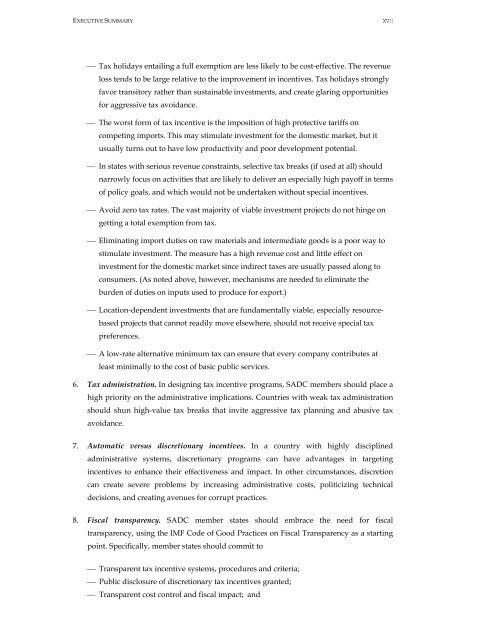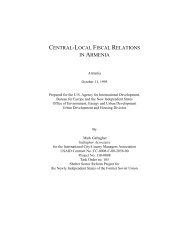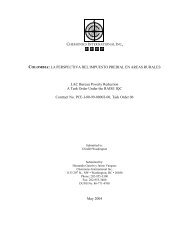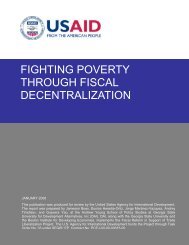Effectiveness and Economic Impact of Tax Incentives in the SADC ...
Effectiveness and Economic Impact of Tax Incentives in the SADC ...
Effectiveness and Economic Impact of Tax Incentives in the SADC ...
Create successful ePaper yourself
Turn your PDF publications into a flip-book with our unique Google optimized e-Paper software.
EXECUTIVE SUMMARY XVII<br />
⎯ <strong>Tax</strong> holidays entail<strong>in</strong>g a full exemption are less likely to be cost-effective. The revenue<br />
loss tends to be large relative to <strong>the</strong> improvement <strong>in</strong> <strong>in</strong>centives. <strong>Tax</strong> holidays strongly<br />
favor transitory ra<strong>the</strong>r than susta<strong>in</strong>able <strong>in</strong>vestments, <strong>and</strong> create glar<strong>in</strong>g opportunities<br />
for aggressive tax avoidance.<br />
⎯ The worst form <strong>of</strong> tax <strong>in</strong>centive is <strong>the</strong> imposition <strong>of</strong> high protective tariffs on<br />
compet<strong>in</strong>g imports. This may stimulate <strong>in</strong>vestment for <strong>the</strong> domestic market, but it<br />
usually turns out to have low productivity <strong>and</strong> poor development potential.<br />
⎯ In states with serious revenue constra<strong>in</strong>ts, selective tax breaks (if used at all) should<br />
narrowly focus on activities that are likely to deliver an especially high pay<strong>of</strong>f <strong>in</strong> terms<br />
<strong>of</strong> policy goals, <strong>and</strong> which would not be undertaken without special <strong>in</strong>centives.<br />
⎯ Avoid zero tax rates. The vast majority <strong>of</strong> viable <strong>in</strong>vestment projects do not h<strong>in</strong>ge on<br />
gett<strong>in</strong>g a total exemption from tax.<br />
⎯ Elim<strong>in</strong>at<strong>in</strong>g import duties on raw materials <strong>and</strong> <strong>in</strong>termediate goods is a poor way to<br />
stimulate <strong>in</strong>vestment. The measure has a high revenue cost <strong>and</strong> little effect on<br />
<strong>in</strong>vestment for <strong>the</strong> domestic market s<strong>in</strong>ce <strong>in</strong>direct taxes are usually passed along to<br />
consumers. (As noted above, however, mechanisms are needed to elim<strong>in</strong>ate <strong>the</strong><br />
burden <strong>of</strong> duties on <strong>in</strong>puts used to produce for export.)<br />
⎯ Location-dependent <strong>in</strong>vestments that are fundamentally viable, especially resourcebased<br />
projects that cannot readily move elsewhere, should not receive special tax<br />
preferences.<br />
⎯ A low-rate alternative m<strong>in</strong>imum tax can ensure that every company contributes at<br />
least m<strong>in</strong>imally to <strong>the</strong> cost <strong>of</strong> basic public services.<br />
6. <strong>Tax</strong> adm<strong>in</strong>istration. In design<strong>in</strong>g tax <strong>in</strong>centive programs, <strong>SADC</strong> members should place a<br />
high priority on <strong>the</strong> adm<strong>in</strong>istrative implications. Countries with weak tax adm<strong>in</strong>istration<br />
should shun high-value tax breaks that <strong>in</strong>vite aggressive tax plann<strong>in</strong>g <strong>and</strong> abusive tax<br />
avoidance.<br />
7. Automatic versus discretionary <strong>in</strong>centives. In a country with highly discipl<strong>in</strong>ed<br />
adm<strong>in</strong>istrative systems, discretionary programs can have advantages <strong>in</strong> target<strong>in</strong>g<br />
<strong>in</strong>centives to enhance <strong>the</strong>ir effectiveness <strong>and</strong> impact. In o<strong>the</strong>r circumstances, discretion<br />
can create severe problems by <strong>in</strong>creas<strong>in</strong>g adm<strong>in</strong>istrative costs, politiciz<strong>in</strong>g technical<br />
decisions, <strong>and</strong> creat<strong>in</strong>g avenues for corrupt practices.<br />
8. Fiscal transparency. <strong>SADC</strong> member states should embrace <strong>the</strong> need for fiscal<br />
transparency, us<strong>in</strong>g <strong>the</strong> IMF Code <strong>of</strong> Good Practices on Fiscal Transparency as a start<strong>in</strong>g<br />
po<strong>in</strong>t. Specifically, member states should commit to<br />
⎯ Transparent tax <strong>in</strong>centive systems, procedures <strong>and</strong> criteria;<br />
⎯ Public disclosure <strong>of</strong> discretionary tax <strong>in</strong>centives granted;<br />
⎯ Transparent cost control <strong>and</strong> fiscal impact; <strong>and</strong>











